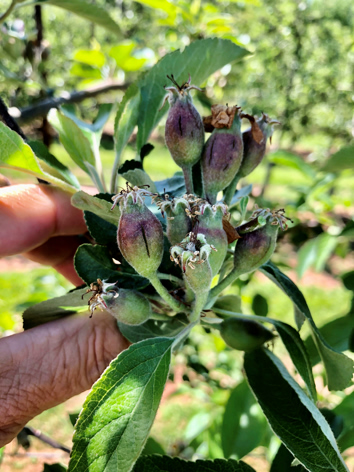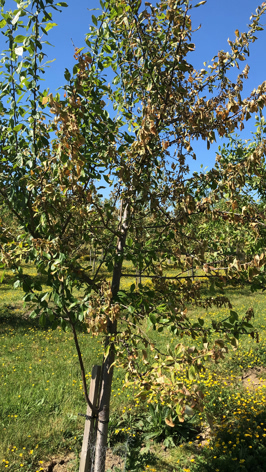

It is at this time of the year when growers and agronomists are assessing the potential fruit set and prospects for this season's apple and pear crops.
In 'days gone by' when trees were much larger and the fruitlets were hidden by leaves, the wise old sages would proclaim: "best go away and come back after Derby Day" - it was amazing how trees which appeared to carry very few fruitlets, changed and by early June (Derby Day) many a grower would say "where did they all come from?
In today's orchards where trees are small and fruitlets are almost ALL visible soon after blossom develops into tiny fruits, assessment is much easier. Of course it does not necessarily turn into a full crop - previous weather events may influence a heavier than natural 'drop' (we always called this the June Drop) but it is usually late June/ early July before the natural thinning takes place.
So growers and agronomists must decide the action required to enhance the final crop yield and quality!
Observing the trees in my own garden, the fruit set on the trees which had plenty of blossom is heavy, although I have trees which had little or no blossom and by definition, no fruit.
Picking up information from my Agronomist friends, the comments are: "Generally the crop set is good to excessive
Plenty of thinning has been done with some to follow and I suspect some retreating (another application) will also be undertaken.
Scab has become an issue on many orchards - Mildew is ok at present but I suspect it will become an issue".
AND: "There are issues with skin finish after the wind and frost, especially pears.
Crop set looks good to ok to me. Depends on variety but generally ok.
Some orchards appear a little light in the bottom of the tree but better higher up. A sure sign of frost.
One year wood blossom set has been poor in most places.
It makes chemical thinning decisions difficult when there is hail damage visible, frost lick, and now scab appearing in places and already showing on fruit.
I think that very few of my customers have chemically thinned much at all. The weather has done most of it and will leave a light quality hand thin if available labour.
AND From The West Midlands
"Set here is variable to say the least. In the past week I have seen an orchard wiped out by frost, some severely damaged, yet have been discussing thinning strategies in others.
Growers' mood could be better!
Jazz apples split by the frost below and a plum tree scorched by the frost (and all the plums black and shrivelled).
Below: left; Jazz split by frost and right; Plum tree scorched by frost


The English Apple Man Comments on thinning
In the early days of thinning (I don't remember any in my Father's day) we thinned to bring a more marketable (bigger) fruit size at harvest. Since then the science has determined that size at harvest, although very important commercially (price) is just one factor in the equation.
The optimum time for thinning is early: e.g. circa 12mm for internal fruit quality determined by 'dry matter content' which is also critical in optimising storage longevity and eating quality out of long term storage.
In the fresh apple market fruit must be crisp and juicy to attract buyers to purchase again. However, recent studies have shown that consumer acceptability could be further enhanced by improving taste. This study evaluates the use of fruit dry matter concentration (DMC) as a new fruit quality metric for apple.
Below: a bunch of five fruitlets before thinning
Thinning by Hand
When fruitlets set heavily (5+ per bunch) it is essential to reduce the numbers to no more than two per bunch. That may be too many, but if necessary the total fruit numbers per tree can be reduced during the summer.
Always remove the King Fruit (the centre of the bunch) which is more likely to be of poor shape.
My trees are small (about 5 feet tall) and pruned to become a small fruit wall. I counted 30 bunches which reduced to 2 apples per bunch (60 apples) is ample for the relatively small tree
Below: left; the first fruitlet removed is the King fruit (centre) and right; the bunch thinned to two fruitlets
Below: on another tree, an equally very heavy fruit set
Below: left; selecting the King fruit for removal and right; King fruit removed
Below: reduced to two fruitlets
And a message from my friend in Oxfordshire who supplied the same trees (variety) as mine shown in these pictures.
Hello John. "Never thought I would say this again, after the wettest winter in memory, but we need RAIN!
"Trees look lovely, though, and the bees are having a ball - over 200 lb of "wild" honey from two hives already.
That yield would be an astonishing crop for a whole year, in the UK.
My BPs were swamped with blossoms - so I have been vigorous with the scissors, reducing the fruit-load.
That is all for this week
Take care and stay safe
The English Apple Man